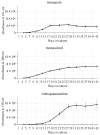A Review of Red Yeast Rice, a Traditional Fermented Food in Japan and East Asia: Its Characteristic Ingredients and Application in the Maintenance and Improvement of Health in Lipid Metabolism and the Circulatory System
- PMID: 33803982
- PMCID: PMC8001704
- DOI: 10.3390/molecules26061619
A Review of Red Yeast Rice, a Traditional Fermented Food in Japan and East Asia: Its Characteristic Ingredients and Application in the Maintenance and Improvement of Health in Lipid Metabolism and the Circulatory System
Abstract
Red yeast rice has been used to produce alcoholic beverages and various fermented foods in China and Korea since ancient times; it has also been used to produce tofuyo (Okinawan-style fermented tofu) in Japan since the 18th century. Recently, monacolin K (lovastatin) which has cholesterol-lowering effects, was found in some strains of Monascus fungi. Since statins have been used world-wide as a cholesterol-lowering agent, processed foods containing natural statins are drawing attention as materials for primary prevention of life-style related diseases. In recent years, large-scale commercial production of red yeast rice using traditional solid-state fermentation has become possible, and various useful materials, including a variety of monascus pigments (polyketides) that spread as natural pigments, in addition to statins, are produced in the fermentation process. Red yeast rice has a lot of potential as a medicinal food. In this paper, we describe the history of red yeast rice as food, especially in Japan and East Asia, its production methods, use, and the ingredients with pharmacological activity. We then review evidence of the beneficial effects of red yeast rice in improving lipid metabolism and the circulatory system and its safety as a functional food.
Keywords: LDL-cholesterol; Monascus fungi; cardiovascular system; lipid metabolism; monacolin; pigment; polyketide; red yeast rice; solid-state fermentation; statin.
Conflict of interest statement
The authors declare no conflict of interest. No funding body had a role in the writing of this review.
Figures


















References
-
- Endo A. History and recent trends about red koji and Monascus fungi. Ferment. Ind. 1985;43:544–552. (In Japanese)
-
- Tsukioka A., Hiroi T., Suzuki T. Pigment Production by Mutants of Monascus anka. J. JSBBA. 1986;60:451–455. (In Japanese)
Publication types
MeSH terms
Substances
LinkOut - more resources
Full Text Sources
Other Literature Sources

